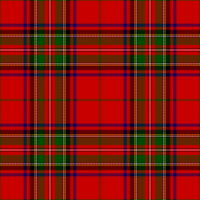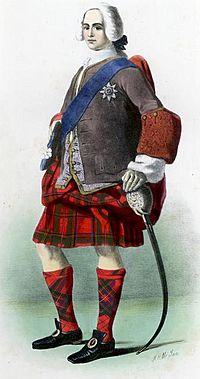Clan Stewart facts for kids
Quick facts for kids Clan Stewart |
|||
|---|---|---|---|
| Stiùbhart | |||

Crest: Due to a lack of a Chief, members sometimes use the badge belonging to the Earl of Galloway. A pelican Argent, winged Or, in her nest feeding her young, Proper.
|
|||
| Motto | Virescit vulnere virtus (Courage grows strong at a wound) | ||
| Profile | |||
| Region | Lowlands and Highlands | ||
| District | Renfrewshire, Teviotdale and Lauderdale. | ||
| Plant badge | Thistle | ||
| Pipe music | Bratach Bhàn nan Stiùbhartach (The white banner of the Stewarts) | ||
 |
|||
| Clan Stewart has no chief, and is an armigerous clan | |||
| Commander | The Earl of Galloway is considered to be the senior cadet, but is not chief. | ||
|
|||
|
|||
|
|||
|
|||
Clan Stewart (Scots: Clan Stewart) (Gaelic: Stiùbhart) is a famous Highland and Lowland clan. A clan is like a large family group, often with a shared history and a chief. The Clan Stewart is recognized by the Court of the Lord Lyon, which is Scotland's official authority on heraldry and clans.
However, Clan Stewart does not have a recognized Clan Chief right now. This means it's considered an armigerous clan (a clan without a chief). Even so, the Earls of Galloway are seen as the main branch of this clan. Their crest and motto are used in the Clan Stewart crest badge. There are two other Stewart/Stuart clans recognized: Clan Stuart of Bute and Clan Stewart of Appin. Only Clan Stuart of Bute has a recognized chief today.
Contents
History of Clan Stewart
How the Clan Began
The Stewart family, who later became kings and queens of Scotland, came from a family in France. They were "seneschals," which means they were important officials who managed a lord's household. After the Normans conquered England, this family, known as FitzAlan, gained lands there.
Walter fitz Alan came to Scotland when David I of Scotland became king. He was given the important job of High Steward of Scotland. This is where the name Stewart comes from! Walter received large estates in Renfrewshire and East Lothian. He was also a leader in the Scottish army. In 1164, he helped defeat Somerled of the Isles at the Battle of Renfrew.
Fighting the Vikings
Later, Alexander Stewart, 4th High Steward of Scotland, also known as Alexander of Dundonald Castle, led the Scottish army. In 1263, he fought against Viking invaders at the famous Battle of Largs. The Scots won, pushing the Vikings out of Scotland.
Wars for Scottish Freedom
During the Wars of Scottish Independence, James Stewart, 5th High Steward of Scotland first promised loyalty to Edward I of England. But he soon changed sides. He joined Robert the Bruce and William Wallace to fight for Scotland's freedom from England.
The Royal House of Stewart
The Stewarts became the royal family of Scotland! Walter Stewart, 6th High Steward of Scotland married Marjory, who was the daughter of King Robert the Bruce. When Robert the Bruce's son, David II of Scotland, died without children, Walter Stewart's son, Robert II of Scotland, became the new king.
King Robert II had many sons. His oldest son, John, became King Robert III of Scotland. The Stewart family continued to rule Scotland. Later, they also ruled England. They held the throne until Anne, Queen of Great Britain died in 1714.
The Albany Stewarts
The title "Duke of Albany" was given to younger sons in the Scottish royal family. Robert Stewart, 1st Duke of Albany, was the third son of King Robert II. He acted as Regent (a ruler for a king who is too young or unable to rule). He ruled Scotland for parts of his father's, brother's, and nephew's reigns.
Robert II's fourth son was Alexander Stewart, Earl of Buchan. He was known as the Wolf of Badenoch. He was responsible for destroying Elgin Cathedral.
| Stewart of Stewart | Stuart of Albany | Stuart, Earl of Buchan |
|---|---|---|
| Stewart of Barclye | Stewart of Garlies | Stewart of Minto |
| Stewart of Physgill | Stewart of Bute | Stuart of Bute |
| Stuart, Earl of Moray | Stewart of Atholl | Stewart of Rothesay |
| Stewart, Earl of Carrick | Stewart, Duke of Ross | Stewart, Earl of Strathearn |
| Stewart, Earl of Galloway | Stuart of Darnley | Stuart of Lennox |
| Stewart of Ardvorlich | Stuart, Lord Avandale | Stuart, Lord Ochiltree |
When James I of Scotland became old enough to rule, he wanted to make sure his cousins, the Albany Stewarts, didn't become too powerful. He had Murdoch Stewart, 2nd Duke of Albany, and two of Murdoch's sons, Walter and Alexander, executed.
Main Branches of the Clan
Since the Chief of the Stewarts was also the King, the different family branches had a unique relationship. However, they still had their own special badge and tartan. Besides the royal family, three main Stewart branches settled in the Scottish Highlands in the 1300s and 1400s. These were the Stewarts of Appin, Stewarts of Atholl, and Stewarts of Balquhidder. Today, the Earls of Galloway are seen as the most senior line of the Clan Stewart.
Stewarts of Appin
The Stewarts of Appin are descended from Sir John Stewart of Bonkyll. His younger son, James Stewart, died in 1333 at the Battle of Halidon Hill. James's grandson married the daughter of the Lord of Lorne. This made him the first Stewart Lord of Lorne. The Stewarts of Appin were loyal to the King during the Civil War in the 1600s. They also supported the deposed Stuart monarchs during the Jacobite rising of 1715 and Jacobite rising of 1745.
Stewarts of Atholl
The Stewarts of Atholl come from a son of Alexander Stewart, Earl of Buchan, the "Wolf of Badenoch." James Stewart built a strong castle at Garth in the late 1300s. Later, Queen Joanna, who was the widow of James I of Scotland, married the Black Knight of Lorne. Their son, John Stewart of Balveny, was given the title Earl of Atholl by his half-brother, James II of Scotland. He helped his brother by leading the royal army against a rebellion.
The fifth Stewart Earl of Atholl died without any sons. His daughter married William Murray, who became the Earl of Atholl. Many Stewarts continued to live in the Atholl area. They were known as Athollmen and were loyal to the Murray Earls of Atholl. This tradition continues today with the Atholl Highlanders, Europe's only private army. General David Stewart of Garth, an Athollman, was a famous officer. His book helped make the Highlands popular in Victorian England.
James Stewart of Sticks and Ballechin (died 1523) was an illegitimate son of James II, King of Scotland. He was the ancestor of several other Stewart families in Atholl. These include the Stewarts of Arnagang, Ballechin, and Innervack.
Stewarts of Balquhidder
Stewarts arrived in Balquhidder around 1490. William Stewart, a grandson of the only son of the Duke of Albany who escaped execution by James I, was made the official in charge of the crown lands of Balquhidder.
Stuarts of Bute
The chiefs of the Clan Stuart of Bute are descended from Sir John Stewart. He was an illegitimate son of Robert Stewart, who reigned as Robert II of Scotland.
Earl Castle Stewart
The title Earl Castle Stewart is from County Tyrone in Ireland. It was created in 1800 for Andrew Thomas Stewart. The Earls Castle Stewart claim to be the direct male descendants of the Scottish Royal House of Stuart. They come from Sir Walter Stewart (died 1425), who was the Keeper of Dumbarton Castle. He was a younger son of Murdoch Stewart, 2nd Duke of Albany, who was a son of Robert Stewart, 1st Duke of Albany, and a younger son of King Robert II of Scotland.
Castles of the Stewarts


The Stewarts owned many important castles throughout Scotland:
- Edinburgh Castle was one of the most important castles owned by the Stewarts as the royal family.
- Stirling Castle was another very important royal castle for the Stewart monarchs.
- Linlithgow Palace was a main home for the Stewart and Stuart kings and queens of Scotland.
- Falkland Palace was bought by the Stewart family in the 1300s. It was a royal palace and owned by Robert Stewart, Duke of Albany.
- Castle Stuart was the home of the Stuarts who held the title Earl of Moray.
- Castle Stalker was a home for the Stewarts of Appin.
- Lochranza Castle was given to Walter Stewart, the Earl of Menteith in 1262 by Alexander III of Scotland.
- Dundonald Castle was built in the 1200s by Alexander Stewart, 4th High Steward of Scotland. It was used by the Stewart monarchs.
- Craigmillar Castle, in Edinburgh, was another castle of the royal Stuarts.
- Doune Castle was built in the 1300s by Robert Stewart, Duke of Albany.
- Earl's Palace, Kirkwall was built by Robert Stewart, 1st Earl of Orkney.
- Bishop's Palace, Kirkwall was originally a Norwegian fort. It later belonged to Robert Stewart, 1st Earl of Orkney.
- Scalloway Castle was built by Patrick Stewart, 2nd Earl of Orkney.
- Earl's Palace, Birsay was also built by Patrick Stewart, 2nd Earl of Orkney.
- Crookston Castle was owned by different branches of the Clan Stewart.
- Rothesay Castle was built by the Stewarts in the early 1200s.
- Drumin Castle was the home of Alexander Stewart, Earl of Buchan (the Wolf of Badenoch).
- Ardvorlich Castle was a strong home for the Stuarts of Balquhidder.
- Garth Castle was a stronghold of the Clan Stewart.
- Grandtully Castle was another stronghold of the Clan Stewart.
- Garlies Castle was a stronghold of the Clan Stewart.
- Castle Campbell, first called Castle Gloom, passed to the Campbells through marriage. They changed its name in 1489.
Stewart Tartans
A tartan is a patterned cloth, usually wool, that shows the colors and design of a specific Scottish clan. The most common tartan for the Stewarts or Stuarts is a red pattern called the Royal Stuart Tartan. Historian Henry James Lee said that seeing many men in the red Stuart tartan crossing a hill looked "as if the hill were on fire."
| Tartan image | Notes |
|---|---|
 |
Clan Stewart tartan, as published in 1842 in the Vestiarium Scoticum. |
See also
- Armorial of the House of Stuart
- Scottish clan
- Armigerous clan
- High Steward of Scotland
- House of Stuart
- Marquess of Bute Crichton-Stuart of Bute
- Earl of Galloway Stewart of Galloway
- Earl of Moray Stuart of Moray
- Earl of Traquair Stewart of Traquair
- Earl of Wharncliffe
- Earl Castle Stewart Stewart in County Tyrone
- Viscount Stuart of Findhorn
- Lord Ochiltree
- Lord Avondale
- Lord Methven
- Lord Blantyre
- Baron Stuart de Decies
- Baron Stuart de Rothesay
- Baron Stuart of Wortley
- Duke of Albany
- Duke of Monmouth James Scott, eldest illegitimate son of Charles II, attainted
- Duke of Buccleuch and Duke of Queensberry Descendants of James Scott, the Duke of Monmouth
- Duke of Cleveland and Duke of Southampton Descendants of Charles FitzRoy, an illegitimate son of Charles II, extinct
- Duke of Grafton Descendants of Henry FitzRoy, an illegitimate son of Charles II
- Duke of St Albans Descendants of Charles Beauclerk, an illegitimate son of Charles II
- Duke of Richmond, Duke of Lennox and Duke of Gordon Descendants of Charles Lennox, an illegitimate son of Charles II
- Duke of Berwick Descendants of James FitzJames, the illegitimate son of James II, attainted, almost extinct
- Duke of Fitz-James Descendants of James FitzJames, the illegitimate son of James II, extinct























